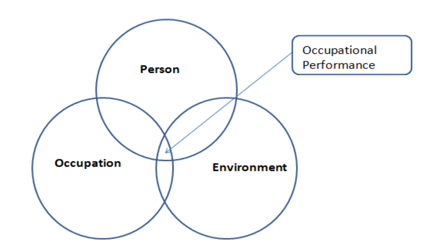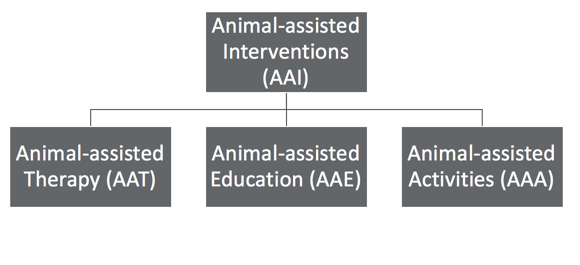Introduction
Good morning everyone. I am excited to present on this topic. This course today will provide an overview of the role of pet ownership for older adults and the role of occupational therapy practitioners in supporting that human-animal bond. I will first explain how occupational therapy practitioners are trained to help older adults. And in the second section, I will go over the benefits of owning pets and the role of occupational therapy practitioners in support of this relationship will be discussed. In the final section, the occupational therapy process will be highlighted and how we can incorporate pet care into our treatment plans. My hope is that this course will help occupational therapy practitioners recognize the importance of pet ownership among older adults and moreover prompt and direct your services.
Role of Occupational Therapy
The number of Americans, age 65 years or older, represent one of the fastest growing population groups in the United States. By 2030, it is projected that one in five Americans will be 65 years and over (U.S. Census Bureau QuckFacts). Many older adults, as we know, can experience detrimental health concerns related to physical, cognitive, and social deficits, and unfortunately, these impairments often impact the older adult's capacity to live independently and engage in meaningful occupations (Colby & Ortman, 2015). I want to remind us, occupations are often referred to as the chunks of activity that are meaningful and given value by the individual and their surroundings (Law et al., 1996). An example of occupations for an elderly man might be feeding animals, tending to yard work, and helping around the house.
Occupational therapy practitioners are uniquely trained to understand how everyday occupations and context influences overall health and well-being. When a client is experiencing difficulty completing the desired occupation, an occupational therapy practitioner gauges their performance discrepancy. And to do so, we utilize our professional reasoning skills to inform and ensure our practice is grounded in evidence. Professional reasoning is defined as that process that we use to plan, direct, perform and reflect on our client's care. We often use and blend theoretical frameworks, our professional experiences, and supporting literature to guide and rationalize our actions.
Practice Model
One conceptual ecological practice model that many of us turn to for guidance is the Person Environment Occupation Model or the PEO Model as shown in Figure 1.

Figure 1. PEO Model (Law et al., 1996).
This model serves as a foundational basis for understanding the transactive and dynamic relationships that arise when clients engage in occupations within a certain environment. The person domain involves characteristics of each unique being. This may include their roles, life experiences, personality style, and their ability and skills related to motor, sensory, and even cognitive performance. Environment is defined broadly as the context within which occupational performance occurs. This context may be made up of physical, social, cultural, and institutional elements, and considers each of these based on the client. To reiterate, occupations are those chunks of activity in which people meaningfully engage in. Lastly, the fluid transaction of the person, environment, and occupation give rise to the quality of the client's occupational performance. For example, the greater the overlap in the middle or the compatibility between the person, environment, occupation, the more optimal the occupational performance quality. In contrast, clients can experience a lack of fit that can ultimately diminish their occupational performance. I encourage occupational therapy practitioners to refer to the PEO, or other similar theoretical frameworks, to help frame the scope of their practice to promote their clients' full participation in their everyday lives.
Occupations=Instrumental Activities of Daily Living (IADL)
Occupational therapy services target a variety of occupations. And the Occupational Therapy Practice Framework's: Domain and Process (2014) identifies one area of occupation as instrumental activities of daily living or IADLs. As we know, IADLs are those activities that support daily life within a home and community, and often these activities require more complex interactions. Examples of IADLs include child-rearing, care for others, care of pets, communication device use, health and maintenance, driving and community mobility, financial management, shopping, and home management. Given the complex nature of IADLs, one study, by Baker (2005), claims that the level of independence of an older adult depends largely on his or her ability to execute an IADL. Other research has suggested that older adults, that face limitation in the ability to perform IADLs, may encounter diminished quality of life and further may prompt the need for personal assistance or even relocation to an institutional care facility. Therefore, it is important that we promote functional independence and enhanced quality of life among older adults. Occupational therapy practitioners must attend to IADLs.
Pet Care: The Forgotten IADL
Evidence suggests that pet care may be neglected when working with older adults (Orellano et al., 2012; Kaushi, 1999; Grier, 2006; APPA, 2017). A systematic review of research was conducted on IADL performance among community-dwelling older adults. And of the 40 included studies, none of them explored the effect of occupation and activity-based interventions on older adult's performance of pet care as an IADL. And this paucity of pet care knowledge is startling, given the role of animals has dramatically changed over recent decades. As many of us know, animals were once used strictly for work purposes in the United States, such as agricultural development, but pets have increasingly played a significant role in the lives of people since then.
The meaning and significance people place with animals is often shaped by their role of the pet owner. The term pet can be understood and represents animals that are sought-out and kept for pleasure. Today, more than 75% of people have at least one pet. Baby boomers, people ranging in age from 53 to 71 years old, account for 32% of pet owners in the United States alone. Although the role of pet ownership, and all it entails, has not received much attention in occupational therapy, there has been some effort to illustrate the potential benefits for older adults interacting with animals, in particular, their pets.
Benefits and Risks of Animals for Older Adults
Benefits:
- Caring and nurturing
- Exercise
- Social interactions
- Prevent decline in performing activities of daily living
- Increase in health
- Decrease in service utilization
Risks:
- Falls
- Financial burden
- Mobility and cognitive decline
- Psychological
(Anderson, Reid, & Jennings, 1992; Bauman, Russell, Furber, & Dobson, 2001; Dembicki & Anderson, 1996; Headey, 1999; Raina, Waltner-Toews, Bonnett, Woodward, & Abernathy, 1999; Serpell, 1991; Leland et al., 2012; Centers for Disease Control and Prevention, 2016; Beck & Katcher, 2003; Parslow et al., 2005)
For older adults, many maintain and cherish their role of the pet owner to fulfill caring and nurturing tendencies, to encourage exercise, and to facilitate positive social interactions. Numerous studies have found pet ownership associated with better overall health and in particular cardiovascular health. These positive effects have been found to be especially promising for older adults. In addition to cardiovascular health, as compared with older adult non-pet owners, pet owners display slower deterioration of the ability to perform activities of daily living. Other studies comparing the health of pet owners and non-pet owners suggests that pet owners are healthier, have less pharmaceutical expenditure, and are less likely to be on medication for heart problems and sleeping difficulties.
Dogs can also impact exercise levels. Dog owners, as compared to other pet owners and non-pet owners, experience an increase in daily physical exercise. It is been suggested by many that dog walking may be a viable strategy to combat the frequent decline of physical activity that often accompanies the aging process. In addition to physical benefits, many studies have also recognized the power of pets or animal interactions in increasing social behaviors and providing social support to older adults. For older adults who often have limited social connections, relationships with their pets can acquire an even greater importance as many older adults do not have opportunities to establish new social contacts. Pets are one option for satisfying this emotional relationship. Several studies have found that pets can serve as a buffer against feelings of loneliness and may compensate for low social connectedness. In addition, pets can add meaning, structure, and purpose to the lives of older adults. They can give owners a reason to stay active and keep on a regular schedule.
While much research has shown these positive outcomes of pet ownership or animal interactions, older adults may also experience adverse consequences. Older adults are at an increased risk for falls due to a combination of medical, social, and environmental influences. More than 800,000 older adults are hospitalized each year because of a fall injury. One study reported that 56% of older adults that fell and sustained a hip fracture was due to an object in the home environment. And, one of the most common environmental hazards noted in that study was pet-related objects or even the pet.
In addition to physical risk, older adults may experience a financial burden. Many older adults, as we know, live on fixed incomes which require particular attention to budgeting and keeping unnecessary costs to a minimum. Owning and properly caring for a pet requires that one purchase food, pet supplies, and necessary services. These costs may contribute to an older adult's financial difficulties. The American Pets Product Association (2017) reported that U.S. pet owners spent an estimated 30 billion dollars on pet food, 15 billion dollars on pet supplies, 17 billion dollars on veterinary care, and another 6 billion dollars on other services, such a grooming.
As adults age, many experience mobility and cognitive limitations. These limitations may impede the older adult from being able to provide necessary daily pet care tasks. For example, a pet owner may struggle to walk their dog because of necessary mobility aids, such as a walker. Likewise, many older adults may have mobility restrictions, such as driving, due to poor vision, and consequently, they cannot transport their pet to a veterinarian for care. Caring for a pet also requires cognitive functions such as memory and sequencing. For instance, a pet owner, feeding his cat, will need to remember when to feed the cat and the steps involved in the process.
Further, pet ownership can impose psychological risks. Older adults who are closely bonded with their pets may experience intense grief when the pet passes away. One study found that community-based older Australians, that owned pets, reported more depressive symptoms than non-owners.
The potential benefits and risks of pet ownership among older adults suggest that occupational therapy practitioners need to be prepared to address and focus on pet care for their older adult clients.
Types of Animal-Assisted Interventions
What are the different types of animal-assisted interventions and how do we classify and understand them? Animal-assisted intervention is an umbrella term that is defined as goal oriented and structured interventions that intentionally incorporate animals and health, education and human service for the purpose of therapeutic gains, and improved health and wellness. Animal-assisted therapy, animal-assisted education, and animal-assisted activities are all forms of animal-assisted interventions as shown in Figure 2.

Figure 2. Animal-assisted interventions (Petpartners.org, 2017).
Animal-assisted therapy is defined as goal-oriented, planned, structured, and documented therapeutic intervention directed by a Health and Human Service provider as part of their profession. A wide variety of disciplines may incorporate animal-assisted therapy, one being occupational therapy. Animal-assisted education is defined as goal oriented, planned, and structured interventions directed by a general education or special education professional. The focus of these activities is on academic goals with student progress being both measured and documented. Lastly, animal-assisted activities can provide opportunities for motivational, educational, and/or recreational benefits to enhance the quality of life. While more informal in nature, these activities are delivered by specially trained professionals, paraprofessionals, or volunteers.
Occupational Therapy IADL Interventions vs. Animal-assisted Therapy
Many clients can benefit from the inclusion of an animal into a goal-oriented and structured therapeutic intervention (Petpartners.org, 2018). Before involving an animal or a pet in our intervention, we need to think about our client's goals and the level of our training. If you are interested in incorporating animal-assisted therapy as part of your professional application, I would urge you to consider partnering with a Pet Partners therapy team if you do not want to undergo a special certification program. Directly stated from the Pet Partners website,
As a professional, your focus is on your client. Will handling an animal be a distraction? If you plan to use animal-assisted therapy for only certain parts of your day, where will your animal wait? How will you manage their need for breaks and stimulation? And keep in mind that not every animal is well suited for therapy work. If your animal does not enjoy interacting with clients, does this mean you won't offer animal-assisted therapy? Instead, you should consider a team who you schedule ahead of time for specific visits. So imagine being able to identify the most appropriate animal based on your client's needs and preferences. You would have someone who can attend to the animal's needs as they arrive and who have been trained and their animal vetted for safe interactions with strangers. And this person or animal can be an amazing resource for you and your client.
Today's session is focused on how we can adapt and modify whatever needs to be addressed to help our older adult client remain independent as possible in their home and caring for their pets.
Occupational Therapy in Action
When working with clients, occupational therapy practitioners proceed through a dynamic interconnected process which consists of three main components with which we are all familiar: evaluation, occupation-based intervention planning and implementation, and then re-evaluation. This process provides structure and further allows us to customize our occupational therapy services to our specific client's needs.
Evaluation
An evaluation marks the starting point of the occupational therapy process. During this time, the occupational therapy practitioner gathers and analyzes client information in order to inform intervention planning and ultimately help the client achieve desired outcomes. There are three main elements of an evaluation.
- Occupational profile
- Analysis of occupational performance
- Goal planning
(Lynne & Trautmann, 2014; Eakman, Carlson, & Clark, 2010)
The profile contains subjective data or information based on the client's perceptions. Here, we gather information by having a conversation with the client and others that are important in the client's life such as caregivers to create an occupational profile. Typical information in an individual's profile may include their history, such as occupations he or she needs, wants or is expected to perform. It also includes his or her concerns, health-related problems, details related to the occupational context, as well as targeted outcomes. In addition to the occupational profile, we also collect objective data, and this data consists of observations of the client performing selected activities related to their everyday occupations to address those targeted outcomes. Ideally, we should observe the client perform the activity in his or her typical manner in a natural setting. To capture this objective data, we often use standardized assessment tools, specifically intended to measure support and barriers to occupational performance.
